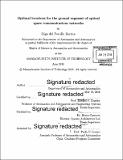| dc.contributor.advisor | Edward F. Crawley and Bruce Cameron. | en_US |
| dc.contributor.author | Del Portillo Barrios, Iñigo | en_US |
| dc.contributor.other | Massachusetts Institute of Technology. Department of Aeronautics and Astronautics. | en_US |
| dc.date.accessioned | 2016-12-05T19:54:48Z | |
| dc.date.available | 2016-12-05T19:54:48Z | |
| dc.date.copyright | 2016 | en_US |
| dc.date.issued | 2016 | en_US |
| dc.identifier.uri | http://hdl.handle.net/1721.1/105609 | |
| dc.description | Thesis: S.M., Massachusetts Institute of Technology, Department of Aeronautics and Astronautics, 2016. | en_US |
| dc.description | Cataloged from PDF version of thesis. | en_US |
| dc.description | Includes bibliographical references (pages 123-126). | en_US |
| dc.description.abstract | Optical communications are envisioned as a key technology for space communication in the near future. This transition to optical terminals is being pushed by the higher data volume demand of certain missions and by the spectrum encroachment in current RF bands. In addition, optical systems present multiple advantages with respect to RF terminals, such as their lower mass, size, and power, as well as the higher data-rate. However, one of the main issues of using optical systems is the space-to-ground link, as it is impossible for the laser beam to penetrate atmospheric clouds. Geographic diversity of ground stations has been proposed as an alternative to mitigate these effects. This thesis uses the systems architecture approach to analyze different architectures for the ground segment of an optical space communications network to serve low Earth orbit (LEO) missions. In particular, we analyze the tradespace characterized by three decisions: 1) number and location of optical ground stations, 2) use of geostationary relay satellites vs. the direct-to-Earth approach and 3) presence of crosslinks among relay satellites. Previous analyses studied the problem of mitigating cloud outage through site diversity both from a simulation perspective (working with point designs or a reduced tradespace composed of a fixed set of candidate locations), and from an analytical standpoint after assuming various simplifying hypotheses (independence of ground stations, uniform cloud conditions across the globe). This thesis expands those assumptions, presents a tool to analyze scenarios where no constraints are placed in the location and proposes a new cloud model to obtain first order approximations for the network availability. In order to analyze the availability of a network of optical ground stations, we use historical weather data from the National Oceanic and Atmospheric Administration (NOAA) and the cloud fraction dataset from Aqua's and Terra's MODIS instruments to characterize weather conditions across the globe. Next, we present the Optical Network Ground Segment Analyzer (ONGSA), a network simulator that incorporates the cloud models to simulate operations of the optical network. Finally we employ ONGSA to explore the aforementioned tradespace and analyze both cost and performance (in terms of availability) for each architecture. Results show that a maximum availability of 95.5 % can be achieved using an architecture similar to the actual system (the Tracking and Data Relay Satellite System) and 12 additional optical ground stations. Furthermore, an unconstrained optimization analysis identified the north of Mexico, southwest of Saudi Arabia, Morocco and central Australia as areas with high potential to construct new ground stations. Building new ground stations was identified to be a more cost-effective solution when the required level of availability is high, while using existing infrastructure is a better solution for systems when the required optical availability is low. Our analysis shows that inter-satellite links (ISL) are a cost-effective solution that adds an extra mitigation layer to combat the effects of cloud coverage. In particular, having ISL results in an increase in availability from 80% with six ground stations to 98.7% with the same number of ground stations. | en_US |
| dc.description.statementofresponsibility | by Iñigo del Portillo Barrios. | en_US |
| dc.format.extent | 126 pages | en_US |
| dc.language.iso | eng | en_US |
| dc.publisher | Massachusetts Institute of Technology | en_US |
| dc.rights | M.I.T. theses are protected by copyright. They may be viewed from this source for any purpose, but reproduction or distribution in any format is prohibited without written permission. See provided URL for inquiries about permission. | en_US |
| dc.rights.uri | http://dspace.mit.edu/handle/1721.1/7582 | en_US |
| dc.subject | Aeronautics and Astronautics. | en_US |
| dc.title | Optimal locations for the ground segment of optical space communications networks | en_US |
| dc.type | Thesis | en_US |
| dc.description.degree | S.M. | en_US |
| dc.contributor.department | Massachusetts Institute of Technology. Department of Aeronautics and Astronautics | |
| dc.identifier.oclc | 962486064 | en_US |
